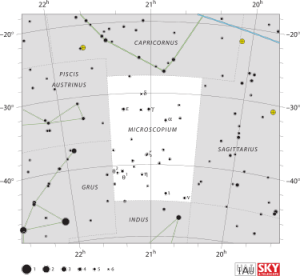Microscopium: Difference between revisions
(Created page with "Microscopium is a small constellation in the southern sky, defined in the 18th century by Nicolas Louis de Lacaille. Its brightest star is Gamma Microscopii of apparent magnit...") |
|||
| (6 intermediate revisions by the same user not shown) | |||
| Line 1: | Line 1: | ||
[[File:375px-Microscopium IAU.svg.png|thumb|Microscopium]] | |||
Microscopium is a small constellation in the southern sky, defined in the 18th century by Nicolas Louis de Lacaille. Its brightest star is Gamma Microscopii of apparent magnitude 4.68, actually a yellow giant located around 381 light-years distant. Two star systems—WASP-7 and HD 205739—have been found to have planets, while another—AU Microscopii—has a debris disk. | Microscopium is a small constellation in the southern sky, defined in the 18th century by Nicolas Louis de Lacaille. Its brightest star is Gamma Microscopii of apparent magnitude 4.68, actually a yellow giant located around 381 light-years distant. Two star systems—WASP-7 and HD 205739—have been found to have planets, while another—AU Microscopii—has a debris disk. | ||
Microscopium is a small constellation bordered by [[Capricornus]] to the north,[[Piscis Austrinus]] and [[Grus]] to the west, [[Sagittarius]] to the east, [[Indus]] to the south, and touching on Telescopium to the southeast. | Microscopium is a small constellation bordered by [[Capricornus]] to the north,[[Piscis Austrinus]] and [[Grus]] to the west, [[Sagittarius]] to the east, [[Indus]] to the south, and touching on Telescopium to the southeast. | ||
The stars that now comprise Microscopium may formerly have belonged to the hind feet of Sagittarius. | The stars that now comprise Microscopium may formerly have belonged to the hind feet of [[Sagittarius]]. However, this is uncertain as, while its stars seem to be referred to by Al-Sufi as having been seen by Ptolemy, Al-Sufi does not specify their exact positions. | ||
Its name is Latin for microscope; it was invented by Lacaille to commemorate the compound microscope. | Its name is Latin for microscope; it was invented by Lacaille to commemorate the compound microscope. Its stars are very faint and hardly visible from most of the non-tropical northern hemisphere.<ref>[http://en.wikipedia.org/wiki/Microscopium Microscpium]</ref> | ||
==Etymology== | |||
The words micro- and macro- are used in pairs as in microcosm and macrocosm. Hermes Trismegistus's axiom 'As above, so below', meaning that all that is in the Cosmos is mirrored in man the small universe, reflects the macro/micro correspondence. Macro- comes from the Indo-European root *mák- 'Long, thin'. Derivatives: meager (from Latin macer, thin), macro-, macron (mark indicating long sound), amphimacer(three syllables with second unstressed, from Greek makros, long, large), emaciate (to make or become extremely thin, from Latin maciare), mecopteran (insect with beaky structure on head), paramecium (a single-celled microscopic aquatic organism", from Greek mekos, length. [Pokorny mak- 699. Watkins] Macedonia. The Greeks seem to have used the word mikros in the same way as we use the words 'small' and 'little'. <ref>[http://www.constellationsofwords.com/Constellations/Microscopium.htm Constellations of Words]</ref> | |||
==HGS Session References== | ==HGS Session References== | ||
HGS Sessions - Clearing [[Hyperspace Phantom Matrix]] - 3/12/2015 <ref>[ | HGS Sessions - Clearing [[Hyperspace Phantom Matrix]] - 3/12/2015 <ref>HGS Session</ref>HGS Sessions - Clearing [[Tara, Gaia, Cradle of Lyra]]- 3/12/2015 <ref> HGS Session</ref>HGS Sessions - Clearing [[El Obour City, Cairo Governorate, Egypt]] - 4/2/2015 <ref>HGS Session</ref> | ||
==References== | ==References== | ||
| Line 19: | Line 22: | ||
==See Also== | ==See Also== | ||
==References== | |||
<references/> | |||
Found in HGS Manual on Page 108 | |||
Found in HGS Manual on Page 115 | |||
[[Category: | [[Category: Ascension]][[Category: HGS Manual]] | ||
Latest revision as of 19:07, 2 April 2015
Microscopium is a small constellation in the southern sky, defined in the 18th century by Nicolas Louis de Lacaille. Its brightest star is Gamma Microscopii of apparent magnitude 4.68, actually a yellow giant located around 381 light-years distant. Two star systems—WASP-7 and HD 205739—have been found to have planets, while another—AU Microscopii—has a debris disk. Microscopium is a small constellation bordered by Capricornus to the north,Piscis Austrinus and Grus to the west, Sagittarius to the east, Indus to the south, and touching on Telescopium to the southeast.
The stars that now comprise Microscopium may formerly have belonged to the hind feet of Sagittarius. However, this is uncertain as, while its stars seem to be referred to by Al-Sufi as having been seen by Ptolemy, Al-Sufi does not specify their exact positions. Its name is Latin for microscope; it was invented by Lacaille to commemorate the compound microscope. Its stars are very faint and hardly visible from most of the non-tropical northern hemisphere.[1]
Etymology
The words micro- and macro- are used in pairs as in microcosm and macrocosm. Hermes Trismegistus's axiom 'As above, so below', meaning that all that is in the Cosmos is mirrored in man the small universe, reflects the macro/micro correspondence. Macro- comes from the Indo-European root *mák- 'Long, thin'. Derivatives: meager (from Latin macer, thin), macro-, macron (mark indicating long sound), amphimacer(three syllables with second unstressed, from Greek makros, long, large), emaciate (to make or become extremely thin, from Latin maciare), mecopteran (insect with beaky structure on head), paramecium (a single-celled microscopic aquatic organism", from Greek mekos, length. [Pokorny mak- 699. Watkins] Macedonia. The Greeks seem to have used the word mikros in the same way as we use the words 'small' and 'little'. [2]
HGS Session References
HGS Sessions - Clearing Hyperspace Phantom Matrix - 3/12/2015 [3]HGS Sessions - Clearing Tara, Gaia, Cradle of Lyra- 3/12/2015 [4]HGS Sessions - Clearing El Obour City, Cairo Governorate, Egypt - 4/2/2015 [5]
References
- ↑ Microscpium
- ↑ Constellations of Words
- ↑ HGS Session
- ↑ HGS Session
- ↑ HGS Session
See Also
References
Found in HGS Manual on Page 108
Found in HGS Manual on Page 115


